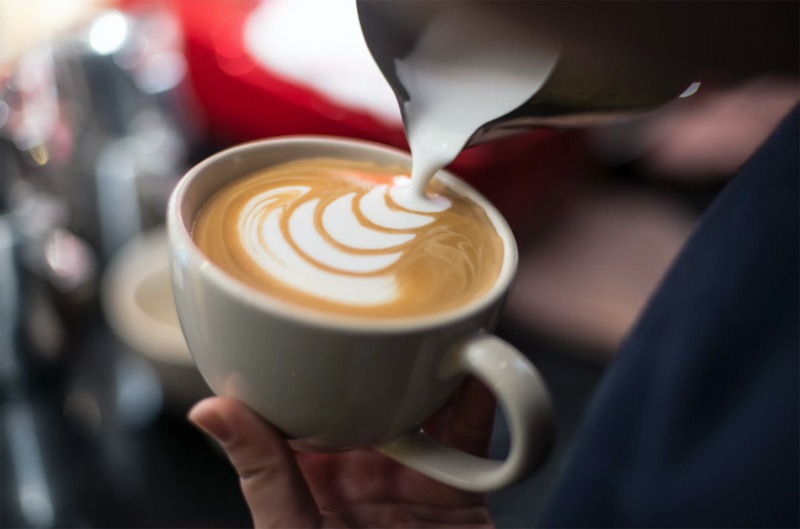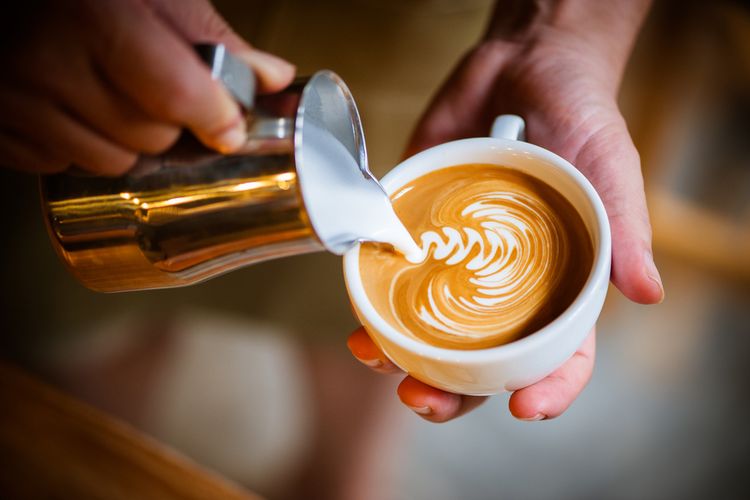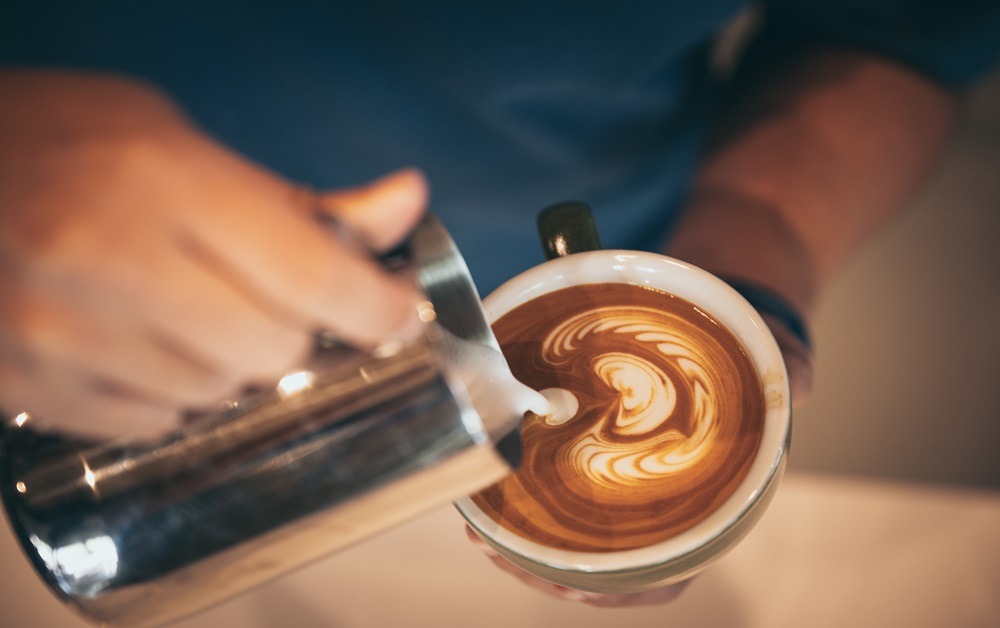Contents
- 0.1 The Basics of Creating Latte Art
- 0.2 Understanding Fire Hazards in Coffee Making
- 0.3 Preventive Measures for Fire Safety
- 0.4 Advanced Latte Art Techniques and Safety Considerations
- 0.5 Safety Measures for Advanced Techniques
- 0.6 Creating a Culture of Safety in Coffee Shops
- 0.7
- 0.8 The Role of Management in Ensuring Safety
- 0.9 Enhancing the Coffee Shop Environment: A Holistic Approach
- 0.10 Sustainability and Environmental Considerations
- 0.11 Future Trends in Coffee Shop Safety and Design
- 1 Author
Latte art has become an essential part of the coffee culture, transforming a simple cup of coffee into a canvas for creativity. Baristas around the world have honed their skills to produce intricate designs on the surface of a latte, from hearts and flowers to more elaborate patterns. However, amidst the pursuit of aesthetic perfection, safety concerns, particularly fire hazards, are often overlooked. This article explores the process of creating latte art, the potential fire hazards involved, and essential safety measures to ensure a safe and enjoyable coffee-making experience.
The Basics of Creating Latte Art
Latte art is the process of pouring steamed milk into a shot of espresso and creating a pattern or design on the surface. The key components include a well-extracted espresso, properly steamed milk, and precise pouring techniques. Here’s a step-by-step guide to creating basic latte art:
- Extract the Espresso: Start by pulling a shot of espresso using freshly ground coffee beans. The espresso should have a rich, dark color with a layer of crema on top, which is essential for latte art.
- Steam the Milk: Use a steam wand to heat and aerate the milk. The goal is to create microfoam, which is milk with tiny, uniform bubbles. This texture is crucial for pouring smooth and controlled patterns.
- Pouring the Milk: Hold the cup at a slight angle and start pouring the milk slowly. As the cup fills, straighten it gradually and pour the milk faster to create a contrast between the crema and the foam. By manipulating the flow and position of the milk, various patterns can be achieved.
Understanding Fire Hazards in Coffee Making
While the art of making coffee, especially latte art, may seem harmless, there are potential fire hazards that can arise in a busy coffee shop environment. These hazards often stem from the equipment used, electrical faults, and improper handling of flammable materials. Identifying and mitigating these risks is crucial for maintaining a safe workplace.
Common Fire Hazards
- Electrical Appliances: Coffee machines, grinders, and steamers are all electrical appliances that pose fire risks if not properly maintained. Faulty wiring, overloaded circuits, and damaged plugs can lead to electrical fires.
- Steam Wand and Milk Frother: The steam wand, used to froth milk, can reach extremely high temperatures. If it comes into contact with flammable materials or if the steam is directed improperly, it can cause burns or start a fire.
- Coffee Grounds and Residues: Accumulation of coffee grounds and residues in and around the espresso machine can be a fire hazard. These residues are highly flammable and can ignite if exposed to high temperatures.
- Flammable Cleaning Agents: Many cleaning agents used in coffee shops contain flammable chemicals. Improper storage and use of these agents can increase the risk of fire.
Preventive Measures for Fire Safety
Ensuring fire safety while creating latte art involves adopting a proactive approach to identify and mitigate potential hazards. Here are some essential safety measures:
Regular Maintenance and Inspections
- Equipment Maintenance: Regularly inspect and maintain all coffee-making equipment. This includes checking for any signs of wear and tear, replacing damaged parts, and ensuring that all electrical components are in good working condition.
- Professional Servicing: Schedule professional servicing of coffee machines and other equipment at least once a year. Professional technicians can identify and address potential fire hazards that may not be visible during routine inspections.
- Cleanliness: Keep the workspace clean and free from coffee grounds and residues. Regularly clean the espresso machine, grinder, and other equipment to prevent the buildup of flammable materials.
Safe Handling of Electrical Appliances
- Proper Wiring: Ensure that all electrical appliances are properly wired and grounded. Avoid using extension cords or power strips, as they can overload circuits and increase the risk of fire.
- Turn Off Equipment: Turn off and unplug all equipment when not in use, especially overnight. This simple step can prevent electrical fires caused by overheating or short circuits.
- Monitor Steam Wand Usage: Be cautious when using the steam wand. Always point it away from yourself and others, and ensure that it does not come into contact with flammable materials.
Storage and Handling of Flammable Materials
- Proper Storage: Store flammable cleaning agents and chemicals in designated, well-ventilated areas away from heat sources. Ensure that all containers are properly labeled and sealed.
- Use of Non-Flammable Cleaners: Whenever possible, use non-flammable cleaning agents to reduce the risk of fire. There are many effective, non-flammable alternatives available for cleaning coffee equipment.
Training and Emergency Preparedness
- Staff Training: Train all staff members on fire safety protocols and the proper use of equipment. Ensure they know how to handle emergencies, including how to use fire extinguishers and the location of emergency exits.
- Fire Drills: Conduct regular fire drills to ensure that all staff members are familiar with evacuation procedures and can respond quickly in case of an emergency.
- Emergency Equipment: Ensure that fire extinguishers, smoke detectors, and other emergency equipment are readily accessible and in good working condition.
Latte art is a beautiful and skillful addition to the coffee-making process, bringing joy to both baristas and customers. However, it is essential to be aware of the potential fire hazards associated with coffee-making equipment and practices. By adopting preventive measures, conducting regular maintenance, and ensuring proper training, coffee shops can minimize luna togel the risk of fire and create a safe environment for everyone. The key is to balance creativity with safety, ensuring that the art of coffee-making remains a delightful and hazard-free experience.
Advanced Latte Art Techniques and Safety Considerations
Once the basics of latte art are mastered, baristas often move on to more advanced techniques, creating complex and visually stunning designs. However, these advanced methods can also introduce new safety concerns that must be addressed.
Advanced Techniques
- Etching: This involves using a fine-tipped tool, such as a thermometer or a specialized latte art pen, to draw intricate designs on the foam. While etching allows for more detailed art, it’s important to be cautious with sharp or pointed tools to avoid injury.
- Free Pouring: This technique relies on the precise control of milk flow and hand movements to create patterns without the aid of tools. Free pouring requires practice and a steady hand, and baristas should ensure that their workspace is clear to prevent accidents.
- Multi-Colored Designs: Some baristas use food coloring or flavored syrups to add color to their latte art. These substances should be handled carefully to avoid spills and contamination, and it’s crucial to use only food-safe, non-toxic materials.
Safety Measures for Advanced Techniques
Handling Tools and Equipment
- Proper Storage: Store all tools, such as etching pens and thermometers, in designated areas when not in use. This helps prevent accidental injuries and keeps the workspace organized.
- Tool Maintenance: Regularly inspect and clean tools to ensure they are in good condition. Damaged or dirty tools can compromise both safety and the quality of the latte art.
Managing Multi-Colored Designs
- Food Safety: Always use food-safe coloring and syrups. Avoid substances that can be harmful if ingested or cause allergic reactions. Ensure that these materials are stored properly and labeled clearly.
- Cleanliness: Maintain a clean workspace to prevent cross-contamination. Spills should be cleaned up immediately, and all surfaces should be sanitized regularly.
Creating a Culture of Safety in Coffee Shops
In addition to individual safety practices, fostering a culture of safety within the coffee shop is essential. This involves promoting awareness, encouraging open communication, and implementing comprehensive safety protocols.
Promoting Awareness
- Safety Meetings: Hold regular safety meetings to discuss potential hazards, review safety protocols, and address any concerns or incidents that have occurred. This keeps safety at the forefront of everyone’s mind.
- Visual Reminders: Post safety reminders and instructions in visible areas of the coffee shop. These can include proper handling of equipment, emergency procedures, and tips for maintaining a safe workspace.
Encouraging Communication
- Open Dialogue: Encourage staff to report any safety concerns or incidents immediately. An open dialogue helps identify potential hazards before they become serious problems.
- Feedback Mechanism: Implement a system for staff to provide feedback on safety protocols and suggest improvements. This can help create a more effective and inclusive safety plan.
Comprehensive Safety Protocols
- Emergency Plan: Develop and regularly update an emergency plan that includes evacuation routes, emergency contact numbers, and procedures for handling different types of emergencies.
- Regular Drills: Conduct regular fire and emergency drills to ensure that all staff members are familiar with the procedures and can respond quickly and effectively in an emergency.
- Safety Equipment: Ensure that all safety equipment, including fire extinguishers, first aid kits, and smoke detectors, is in good working condition and easily accessible.
The Role of Management in Ensuring Safety
Management plays a crucial role in establishing and maintaining a safe environment. This includes not only implementing safety protocols but also setting a positive example and fostering a culture of safety.
Leadership and Accountability
- Lead by Example: Managers should model safe behavior and practices. When staff see management prioritizing safety, they are more likely to follow suit.
- Accountability: Hold staff accountable for following safety protocols. This can include regular performance reviews that incorporate safety practices and addressing any violations promptly.
Training and Development
- Ongoing Training: Provide ongoing training opportunities for staff to stay updated on the latest safety practices and latte art techniques. This can include workshops, online courses, and hands-on training sessions.
- Certification Programs: Encourage staff to pursue certification programs in both barista skills and safety training. These programs can enhance their skills and knowledge, contributing to a safer and more professional work environment.
The art of creating latte art is a delightful and skillful practice that enhances the coffee experience. However, it is crucial to balance creativity with safety to ensure a hazard-free environment. By understanding and addressing potential fire hazards, implementing comprehensive safety measures, and fostering a culture of safety, coffee shops can provide a safe and enjoyable space for both staff and customers. Management’s role in leading by example and providing ongoing training and support is vital in achieving this balance. Ultimately, the goal is to create beautiful latte art while maintaining the highest standards of safety and professionalism.
Enhancing the Coffee Shop Environment: A Holistic Approach
Creating a safe and aesthetically pleasing coffee shop environment extends beyond fire safety and latte art techniques. It involves considering the overall ambiance, customer experience, and employee well-being. Here are some additional aspects to consider:
Ergonomics and Workspace Design
- Ergonomic Workspace: Design the workspace to minimize physical strain on baristas. This includes adjustable workstations, anti-fatigue mats, and properly positioned equipment to reduce repetitive motion injuries.
- Efficient Layout: Arrange the workspace to promote efficient workflow and minimize clutter. This reduces the risk of accidents and allows baristas to focus on creating high-quality beverages and art.
- Adequate Lighting: Ensure that the workspace is well-lit to reduce eye strain and improve accuracy when creating latte art. Proper lighting also enhances safety by making it easier to spot potential hazards.
Enhancing Customer Experience
- Inviting Atmosphere: Create an inviting atmosphere with comfortable seating, pleasing décor, and a clean environment. A welcoming ambiance encourages customers to relax and enjoy their coffee.
- Interactive Displays: Consider adding interactive elements such as live latte art demonstrations or coffee tasting sessions. These activities engage customers and enhance their overall experience.
- Customer Safety: Ensure that customer areas are free from hazards such as slippery floors, uneven surfaces, and obstructed pathways. Clearly mark emergency exits and provide accessible facilities for all customers.
Employee Well-Being
- Health and Wellness Programs: Implement health and wellness programs to support employees’ physical and mental well-being. This can include offering healthy snacks, encouraging regular breaks, and providing access to mental health resources.
- Positive Work Culture: Foster a positive work culture that values teamwork, respect, and open communication. A supportive environment improves employee morale and reduces stress.
- Recognition and Development: Recognize and reward employees for their hard work and creativity. Provide opportunities for professional development, such as advanced training in latte art or management skills.
Sustainability and Environmental Considerations
In addition to safety and aesthetic considerations, modern coffee shops are increasingly focusing on sustainability. Implementing eco-friendly practices not only benefits the environment but also appeals to environmentally conscious customers.
Sustainable Practices
- Reducing Waste: Implement waste reduction strategies such as using reusable cups and utensils, composting coffee grounds, and minimizing single-use plastics. Encourage customers to bring their own cups by offering discounts or incentives.
- Ethical Sourcing: Source coffee beans and other ingredients from ethical and sustainable suppliers. This supports fair trade practices and reduces the environmental impact of coffee production.
- Energy Efficiency: Use energy-efficient appliances and lighting to reduce energy consumption. Regularly maintain equipment to ensure it operates efficiently and replace outdated appliances with more sustainable options.
Community Engagement
- Local Partnerships: Partner with local businesses and organizations to support the community. This can include sourcing ingredients locally, hosting community events, and participating in local charity initiatives.
- Customer Education: Educate customers about sustainable practices and the importance of ethical sourcing. Provide information about the origins of your coffee beans and the environmental impact of different practices.
- Sustainable Menu Options: Offer a variety of sustainable menu options, including plant-based milk alternatives and organic ingredients. Highlight these options on your menu to appeal to environmentally conscious customers.
Future Trends in Coffee Shop Safety and Design
As the coffee industry continues to evolve, new trends and technologies are emerging that can further enhance safety, efficiency, and customer satisfaction.
Smart Technology
- Smart Appliances: Invest in smart coffee machines and equipment that can be remotely monitored and controlled. These appliances often have built-in safety features and can alert staff to potential issues before they become serious problems.
- Automated Systems: Implement automated systems for tasks such as inventory management, scheduling, and maintenance reminders. Automation reduces the risk of human error and ensures that safety protocols are consistently followed.
- Customer Engagement: Use technology to enhance customer engagement, such as mobile ordering apps, loyalty programs, and digital payment systems. These tools streamline the ordering process and improve the overall customer experience.
Innovative Designs
- Modular Designs: Consider modular design elements that can be easily reconfigured to accommodate different needs and events. Modular furniture and fixtures allow for greater flexibility and adaptability.
- Biophilic Design: Incorporate biophilic design principles, which emphasize the connection between people and nature. This can include using natural materials, integrating plants and greenery, and maximizing natural light.
- Inclusive Design: Ensure that the coffee shop design is inclusive and accessible to all customers, including those with disabilities. This includes providing accessible seating, clear signage, and barrier-free entryways.
Creating a safe and aesthetically pleasing coffee shop environment involves a comprehensive approach that balances creativity, safety, and sustainability. By adopting advanced latte art techniques, implementing rigorous safety measures, and fostering a positive work culture, coffee shops can provide a delightful and hazard-free experience for both staff and customers. Additionally, embracing sustainable practices and innovative design trends can enhance the overall ambiance and appeal of the coffee shop. Ultimately, the goal is to create a space where creativity and safety coexist harmoniously, allowing everyone to enjoy the art and science of coffee-making to the fullest.
Also Read This Article: BUCHADA DE BODE: A TRADITIONAL BRAZILIAN DELICACY 2024








